CNC Machining vs 3D Printing: Choosing the Right Manufacturing Method
CNC machining and 3D printing are two of the most ubiquitous custom manufacturing technologies. Both methods are used for prototyping, custom manufacturing, and batch production. However, their unique processes, capabilities, and limitations make them better suited for different applications and products. This article compares CNC vs 3D printing, exploring their processes, materials, applications, and differences, helping you select the best manufacturing process for your project.
How CNC Machining Works
How 3D Printing Works
3D Printing Vs CNC Machining Direct Comparison
CNC vs 3D printing: Selecting The Right Process for Your Project
CNC vs 3D printing: Geometry Capabilities
Material Availability: CNC machining vs 3D Printing
Which is More Cost-effective? CNC vs 3D Printing
3D printing vs CNC Machining for Prototyping and Batch Production
CNC vs 3D printing: Which is More Sustainable?
Impact of CNC vs 3D Printing on End Product Performance
Build Size
Dimensional Accuracy
Conclusion
Why Choose Geomiq
How CNC Machining Works
CNC machining is a subtractive manufacturing process that creates parts by using cutting tools to selectively remove portions of a solid block of material until the desired geometry forms. In this process, a computer-controlled CNC machine holds and positions the cutting tool and the workpiece, controlling their speed, movements, and orientation and continuously adjusting these parameters until the geometry materialises. The subtractive technique of material removal from a solid block is one of the distinguishing characteristics of CNC machining vs 3D printing.

CNC machined parts
Two main categories of CNC machining services exist: CNC milling and CNC turning. In CNC milling, a spindle-mounted rotating cutting tool moves into a stationary workpiece, removing pieces of material on contact. The workpiece and cutting tool move in three or five axes for better access. In CNC turning, on the other hand, the chuck-mounted workpiece rotates while a static cutting tool moves into it. The cutting tool and workpiece also move in multiple axes.
See our comprehensive CNC machining guide to learn everything you need to know about CNC machining processes, materials, applications, benefits, and limitations.
How 3D Printing Works
3D printing is an additive manufacturing process that creates three-dimensional parts by depositing successive layers of raw material until the complete part forms. Various 3D printing services exist and differ by the raw material/feedstock state, raw material delivery system, and how consecutive layers fuse and form. The ISO/ASTM 52900:2021 standard classifies major 3D printing technologies under these seven categories:
- Vat photo polymerisation: A laser selectively cures and fuses consecutive 2D layers of a 3D object from a vat of photosensitive resin. Technologies include Stereolithography (SLA) and Direct Light Processing (DLP).
- Powder bed fusion: A high-energy laser traces out an object’s geometry, layer by layer, onto the surface of a powder bed of raw material (Metal, plastic, or ceramic), causing the particles to selectively fuse in the desired shape. Powder bed fusion technologies include Selective Laser Sintering (SLS), Direct Metal Laser Sintering (DMLS), and Selective Laser Melting (SLM)
- Binder jetting: A liquid binding agent is deposited onto a bed of powder (typically metal, ceramic, or sand), bonding the material together to form each layer. For metal parts, this process is followed by sintering the part. Multi Jet Fusion combines elements of powder bed fusion and binder jetting.
- Material jetting: Droplets of photo polymeric material are selectively deposited onto a build platform and cured layer by layer, similar to how inkjet printers work. This technology enables multi-material and multi-colour printing with high precision. Polyjet is the most common material jetting technology.
- Material extrusion: Filament or material (Metal or plastic) is heated and extruded through a nozzle, building layers to form the object. Fused Deposition Modeling (FDM) is the most common form of this technology.
- Directed energy deposition: Material (Metal or plastic) is directly deposited, in powder or wire form, into a melt pool created by a laser, electron beam, or plasma arc, allowing the creation or repair of metal parts.
- Sheet lamination: Thin layers of material (metal, plastic, or paper) are cut and bonded together layer by layer, using adhesives or thermal bonding. Techniques include Ultrasonic Additive Manufacturing (UAM) for metals.

3D printed parts
The common factor in these 3D printing processes is the layer-by-layer technique of building parts. 3D printing creates parts by “adding” consecutive 2D layers, hence the “Additive manufacturing” designation. See our 3D printing guide to learn everything you need to know about 3D printing technologies, benefits, drawbacks, and applications.
3D Printing Vs CNC Machining Direct Comparison
CNC machining and 3D printing share some similarities. Both are custom manufacturing techniques capable of rapid prototyping and batch production from various materials. They also require the creation of a 3D model, followed by conversion to G-Code before the respective machines produce the parts.
However, this is where the similarities end. The actual manufacturing techniques and various other characteristics vary significantly. Since there are different 3D printing technologies with varying characteristics, we will compare CNC machining vs 3D printing as a whole, focusing on the characteristics that apply to all 3D printing technologies. The table below directly compares 3D printing vs CNC machining.
CNC vs 3D printing comparison table
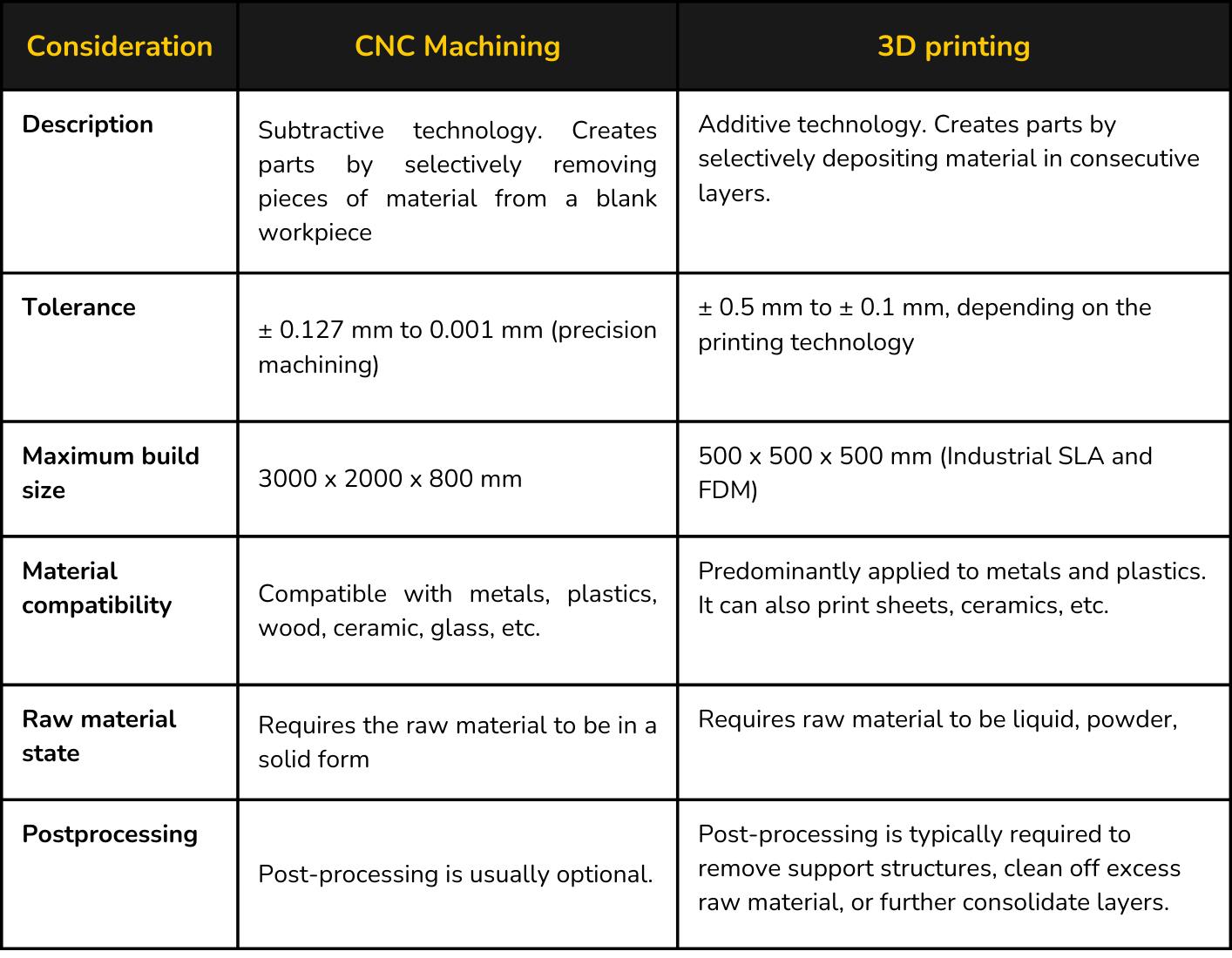
CNC vs 3D printing: Selecting The Right Process for Your Project
CNC machining and 3D printing are both advanced, highly capable manufacturing technologies. However, their unique processes, capabilities, and limitations make them better suited for different applications and products. Selecting the right technology for your part ensures seamless manufacturing and full product functionality. This process involves considering various factors against your project’s requirements. The following are factors to consider when comparing CNC machining vs 3D printing. Some of these factors directly address project considerations, while others focus on the characteristics of the technologies. Note that these considerations are interrelated and should be analysed collectively.
CNC vs 3D printing: Geometry Capabilities
CNC machining is highly capable and can produce immensely complex cubic, parametric, cylindrical, and hexical geometries through 3-axis and 5-axis machining. However, due to the subtractive technique of CNC machining, shape and movement of the cutting tools, and limited access to areas of the workpiece, there are specific geometries this technology cannot produce. These geometries and features include.
- Internal (hollowed out) cavities: These features require the cutting
- Curved channels: The cutting tool is usually straight and can only move in linear directions, making it impossible to create curved channels
- Sharp internal edges: As they are cylindrical, CNC milling tools typically leave rounded edges in internal corners.
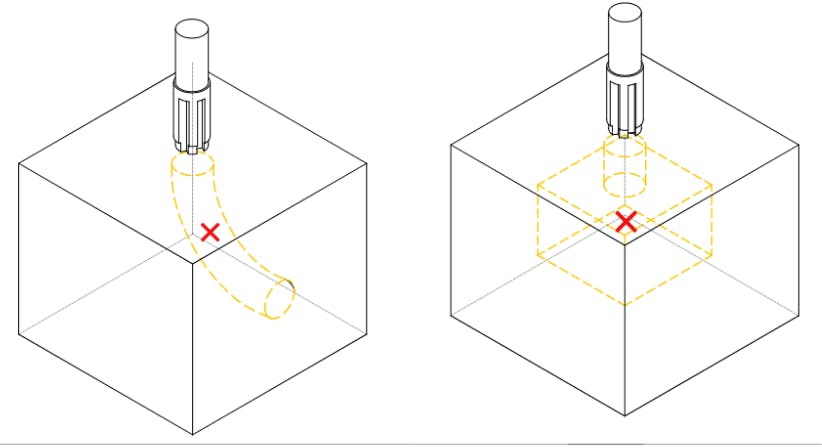
CNC machining geometry restrictions
See of comprehensive CNC design guide for tips and techniques to optimise your design for CNC machining.
3D printing creates parts from scratch, depositing material exactly where it should be in the finished product. This additive technique eliminates geometry limitations in 3D printing, making this technology capable of actualising an extensive range of complex geometries. Note that 3D printing uses layer-by-layer material deposition to build parts. Each layer builds on a previous layer that provides support. As a result, features that do not have preceding layers, such as steep overhangs, horizontal holes, and bridges, may require support structures during printing, depending on the 3D printing technology. Binder jetting and powder bed fusion technologies, such as SLS, MJF, and DMLS, do not require support structures as the solid raw material beds in these technologies provide sufficient support. On the other hand, FDM and SLA 3D printing require support structures. The image below shows a 3D-printed part before support structure removal.

SLA 3D printed part with support structures
Further comparing the geometry capabilities of CNC vs 3D printing, CNC machines typically produce solid single parts that are either standalone or components of an assembly to be assembled later. These parts are usually made of a single material, as CNC machining creates parts from a uniform solid block of material. 3D printing, on the other hand, can create fully functional, dynamic assemblies. In addition, 3D printing technologies such as multi-nozzle material deposition and material jetting can print multicolour and multi-material objects. In summary, CNC machining can produce highly complex geometries and features. However, the 3D printing process has fewer restrictions and offers more design freedom. See our 3D printing design guide to learn how to design for 3D printing.

Multicoloured assembly 3D printing
Material Availability: CNC machining vs 3D Printing
Material plays a vital role when analysing CNC machining vs 3D printing. CNC machining can work with any material that is obtainable in a solid, rigid workpiece. Compatible CNC machining materials include metals, polymers, ceramics, stone, wood, glass, and solid ice. Workpiece rigidity is required to withstand cutting forces, vibrations, and movements.
Polymers CNC machining vs 3D printing
CNC machining can fabricate plastic parts. However, its suitability depends on the plastic’s shore hardness. Rigid plastics with a Shore D hardness of 50 and above are machinable. These materials include:
- ABS (Acrylonitrile Butadiene Styrene)
- PC (Polycarbonate)
- PEEK (Polyether Ether Ketone)
- POM (Polyoxymethylene)
- Acrylic
Flexible plastics and rubbers are more challenging to machine, given their elasticity, tendency to deform under cutting forces, and resistance to tear and abrasion. We recommend a minimum Shore A hardness of 70 for such materials. See our CNC plastic machining article for techniques, benefits, applications, and challenges of machining plastics.

Acrylic CNC machining
CNC machining is predominantly applied to metals. Conversely, 3D printing is more common with plastics. One of the reasons for this is the availability of plastics in various raw material states. Plastics are available as powder, wire, and liquid resin, providing suitable options for all forms of 3D printing. Another primary reason for plastics’ ubiquity in 3D printing is the compatibility between their physical properties and the material deposition and layer consolidation techniques of most 3D printing processes. Solid thermoplastics and elastomers have a relatively low glass transition temperature and are highly malleable when heated. These characteristics make them suitable for sintering or melting 3D printing processes, such as SLS, MJF, and FDM. Similarly, liquid resins which readily undergo curing are suitable for curing-based 3D printing technologies such as material jetting (Polyjet) and vat polymerisation (SLA).
Metal 3D printing vs CNC machining
Metal 3D printing is fast becoming commonplace in the 3D printing industry as many printing technologies apply to metals. Metal 3D printing technologies include direct metal laser sintering, binder jetting, material extrusion, and direct energy deposition. These technologies require the raw materials to be in atomised powder form. DMLS is the most prevalent metal 3D printing technique and can produce parts that match their CNC machined counterparts in terms of properties. The part in the image below was printed via DMLS 3D printing.

DMLS 3D printed part
3D printing vs CNC machining for metals is a common comparison in custom manufacturing. As discussed earlier, choosing between these two technologies for a specific project requires analysing various factors simultaneously. Since both 3D printing and CNC machining can produce metals, selecting between them depends on your project's other requirements. Material availability, cost, and product performance are the main considerations directly related to materials.
Material availability: CNC machining is compatible with hundreds of metals and their alloys. Manufacturers obtain CNC machining workpieces from standard-sized solid metal blanks, typically manufactured via casting. 3D printing, on the other hand, requires powdered metal raw material, which requires advanced atomisation processes. As a result, there are far fewer 3D printing metal material options. At Geomiq, we offer the following industry-standard DMLS 3D printing metals:
- Aluminium Al-Si10Mg
- Cobalt chrome
- Stainless steel 17-4PH
- Stainless steel 316L
- Stainless steel Inconel 615
- Stainless steel Inconel 718
- Titanium
In comparison, we offer over 25 different types of just aluminium alloys for CNC machining.
Cost: Considering the relative novelty of metal 3D printing, you may think that it is outrightly more expensive than CNC machining. However, this is not always the case. The model in the image above costs 60% more to produce from stainless steel 316L via CNC machining than metal 3D printing. The influence of material on cost is the quantity of material used to make a part. DMLS 3D printing uses up to 70% less material than CNC milling to make the same part.
Note that this scenario involves specific geometry, part quantity, and material. While material cost plays a role in the overall cost, it is just one of various factors. We will explore these factors in the cost comparison section of this article.
End product properties: A common misconception when comparing 3D printing vs CNC machining for metals is that 3D printed metal parts lag in strength and performance. However, this is not always the case. Modern metal 3D printing technologies produce parts that match and occasionally surpass the mechanical properties of their CNC-machined counterparts. The charts below compare CNC machined vs 3D printed Stainless steel and aluminium parts. Note that end properties can significantly vary based on material and printing parameters.
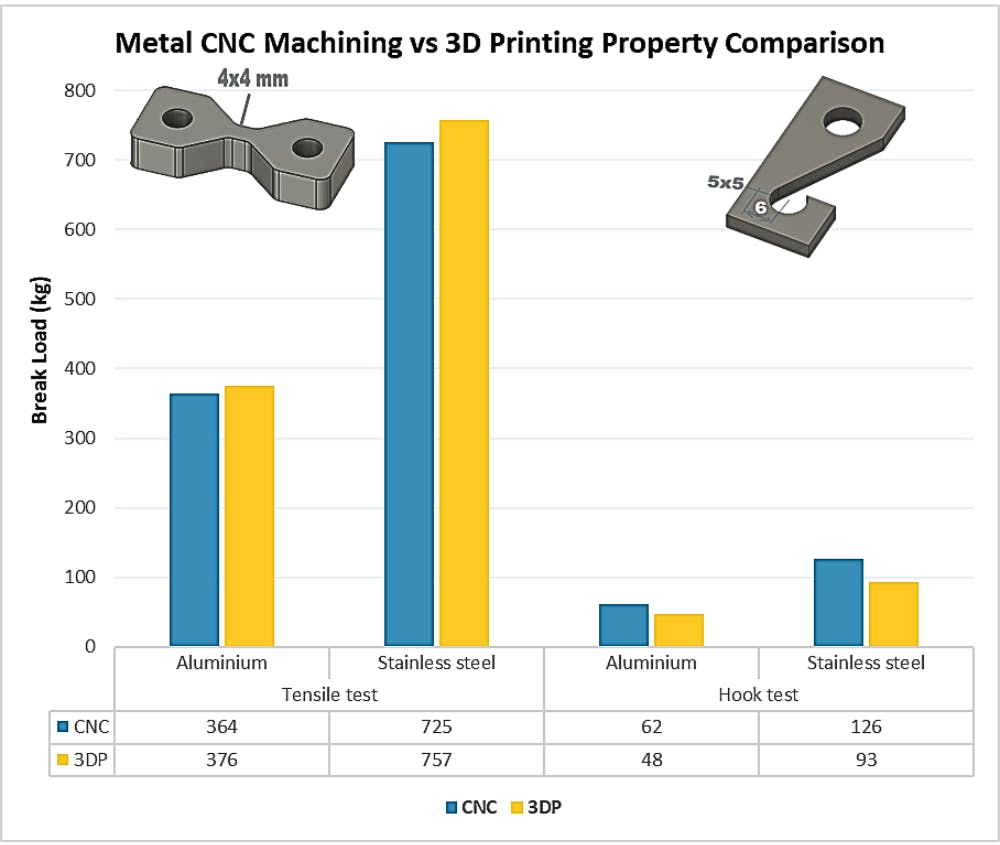
Other Materials
CNC machining is compatible with materials that are obtainable in a solid rigid piece, such as wood, concrete, stone, glass, ceramics, etc. Technically speaking, it is also possible to print wood, cement, and ceramics using powder fusion or material extrusion techniques. In powder fusion, special compounds can be selectively deposited on the powder bed to form parts. Similarly, powdered raw material can be mixed with liquids to create flowable mixtures for material extrusion. In addition, sheet lamination 3D printing is applicable to raw materials obtainable in flat sheets, such as paper and sheet metal.
Which is More Cost-effective? CNC vs 3D Printing
The cost comparison of CNC vs 3d printing can be complex as numerous factors influence costs. Cost varies by project requirements and is significantly influenced by material, part size, geometry, production volume, and other factors. Furthermore, various 3D printing technologies exist with different processes, materials, and cost considerations (surface finishing, roughness, post-processing, etc.), making direct comparisons somewhat complex. For example, it may be impractical to directly compare the cost of CNC machined brass H59 with 3D printed TPU.
However, as a rule of thumb, 3D printing typically costs less than CNC machining for single one-off parts. This is mainly due to the initial tooling and setup costs required in CNC machining, which are non-existent in 3D printing. On the other hand, economies of scale apply to batch productions in CNC machining. The initial CNC machining costs are spread over the number of parts, significantly reducing cost per unit. For example, it costs £134 to machine one unit of the part in the image below from low-cost steel. 10 units cost a total of £385, and 100 units cost £1,300, reducing the cost per unit to £38 and £13, respectively. These price differences represent a 70% and 90% drop in the per unit cost for a single part.

CNC vs 3D printing cost comparison by volume
In 3D printing, the per-unit price differences between production volumes are less significant. For 3D-printed parts, 10 and 100 units will cost 30% - 40% less and 65% less than the price of a one-off part.
3D printing vs CNC Machining for Prototyping and Batch Production
3D printing and CNC machining are widely used for rapid prototyping, custom one-off parts, and batch production. However, their suitability for these applications varies slightly, depending on your project requirements. Cost, speed, and repeatability are the primary considerations when comparing CNC vs 3D printing for different production volumes.
Cost
3D printing typically costs less than CNC machining for single one-off parts as they don't require tooling and use less material. These characteristics make 3D printing more cost-effective for rapid prototyping and one-off parts. However, economies of scale apply to batch productions in CNC machining. The initial CNC machining costs are spread over the number of parts, significantly reducing cost per unit.

CNC machining vs 3D printing cost by the number of parts
Speed
The speed comparison of CNC vs. 3D printing regarding production volume is very similar to cost. Material removal is typically faster than deposition, making machining faster than printing. However, there are other factors to consider. CNC machining requires significant setup time, especially for complex geometries, to prepare the proper tooling and set up the machine. On the other hand, most 3D printing processes require post-processing to remove support structures, clean the parts, or further consolidate layers.
In batch production, the initial CNC tooling prepared is for the entire production. Conversely, each 3D-printed part has to undergo post-processing, usually individually, using manual techniques. Therefore, regarding speed, CNC machining is more suitable than 3D printing for batch production. For one-off parts, suitability varies by part geometry and project requirements.
Repeatability
CNC machines can replicate geometries multiple times without any discrepancies in the parts. This technology allows operators to control various parameters to create uniform, highly accurate parts. 3D printing is more susceptible to slight variations in parts due to potential temperature variations, shrinking, inconsistent printer operation, and individual, manual finishing.

Batch-produced CNC machined parts
In summary, CNC machining is more suitable than 3D printing for batch productions. 3D printing is faster and far more cost-effective for prototyping and one-off productions.
CNC vs 3D printing: Which is More Sustainable?
Additive manufacturing techniques use only the required material quantity to print parts, eliminating material wastage. Some printing technologies, such as FDM and SLA, require support structures that end up as waste, but this is usually minimal. In general, 3D printing raw material utilisation (the percentage of raw material that ends up in the final product) can be over 95%. Conversely, CNC machining has lower material utilisation of 30% to 70%, resulting in much more material wastage. From the image below, a significant portion of the blank volume ends up as waste.

CNC Machined part compared to the initial blank volume
Furthermore, the predominant materials in CNC machining and 3D printing - metals and thermoplastics, are recyclable. However, 3D printing generates far less wastage than CNC machining, making it the more environmentally sustainable option.
Impact of CNC vs 3D Printing on End Product Performance
When end-product performance is critical, manufacturing impact is a vital consideration. CNC and 3D printing have different effects on the properties of the final product. A direct comparison is not typically straightforward, as various aspects of manufacturing impact the final products’ properties. The performance of 3D-printed parts depends heavily on the material quality, printing parameters (laser power, speed, layer thickness, infill, and printing orientation), and post-processing (heat treatment, hot isostatic pressing).
Physical properties
The choice between CNC and 3D printing based on physical properties is sometimes subject to debate. This is due to the slight variations in test results due to parameter variations. The charts below compare the physical properties of CNC machined vs 3D printed ABS, PC, and Nylon parts. FDM was used to print the ABS and PC specimens, and SLS was used to print the nylon.
Tensile Strength Test: This test measures the maximum stress a material can withstand while being stretched or pulled before breaking. It determines a material's resistance to tension. From the chart below, the 3D printed and CNC machined parts performed somewhat similarly, except in nylon, where there’s a significant difference.
CNC vs 3D printing: Tensile strength test
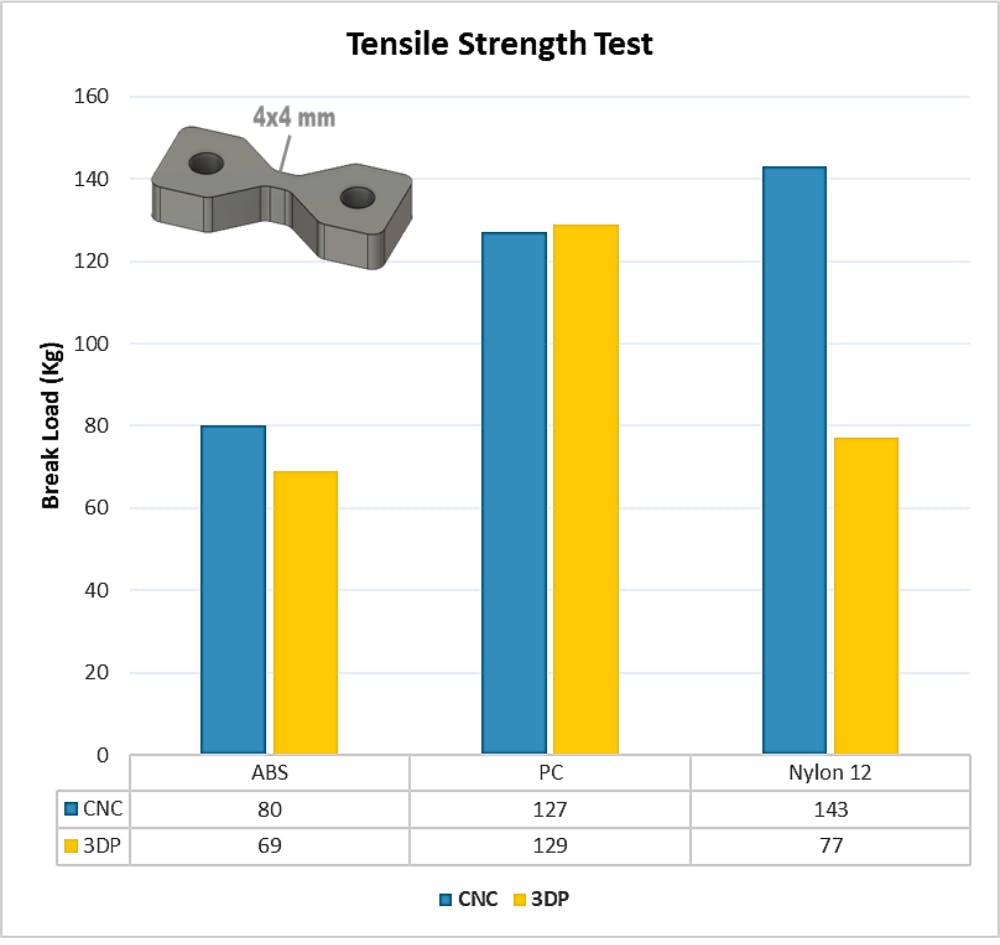
Creep Test: This test evaluates how a material deforms slowly over time under constant stress. It measures the long-term strength and deformation behaviour of materials under prolonged loading. In this test, the ABS and PC parts had similar results. However, the 3D-printed nylon deformed significantly more than its CNC-machined counterpart.
CNC vs 3D printing: Creep test
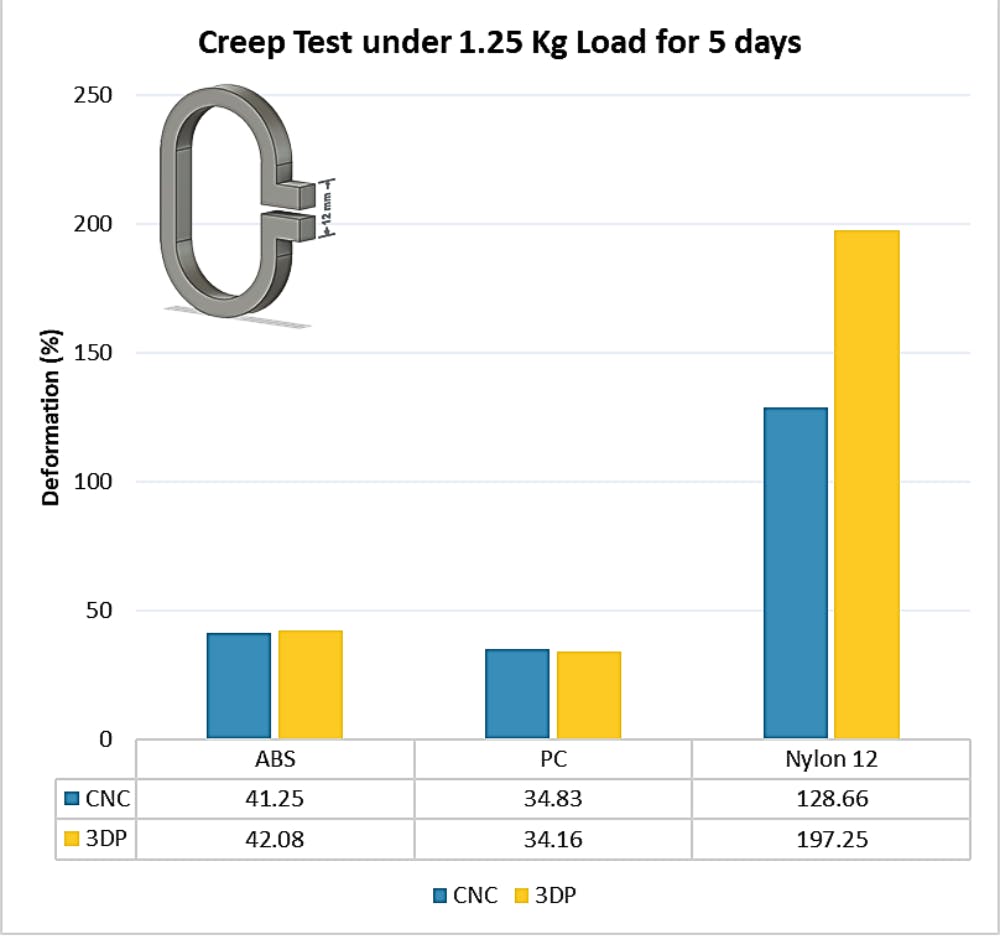
Hook Test: The hook test measures the resistance of a material to deformation or breakage when subjected to a pulling force. It checks the material's tear strength. The CNC machined and 3D printed parts showed very similar results, with the main difference being more significant elongation in machined parts before breakage.
CNC vs 3D printing: Hook test
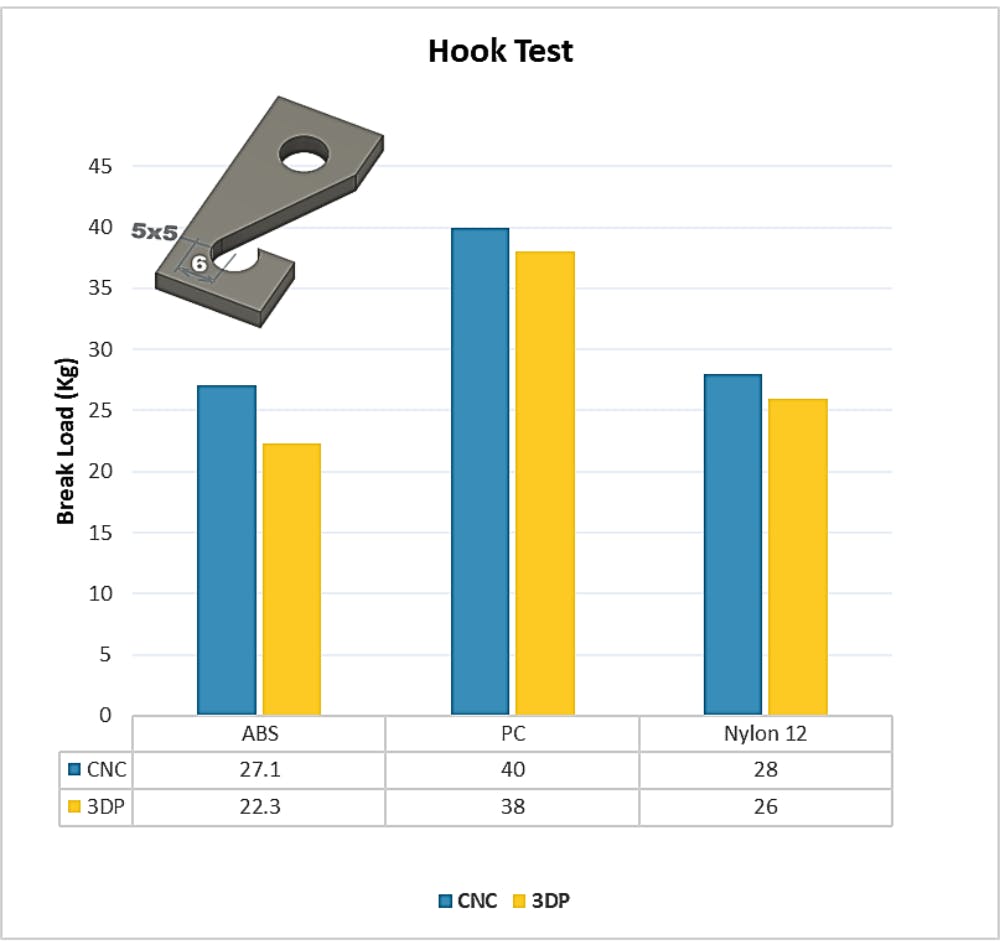
Izod Impact Test: This test measures a material's toughness or impact resistance by determining the energy absorbed when a pendulum strikes a notched sample. It assesses a material's ability to resist sudden impact forces. The CNC-machined parts clearly outperformed their 3D-printed counterparts in this test.
CNC vs 3D printing: Izod impact test
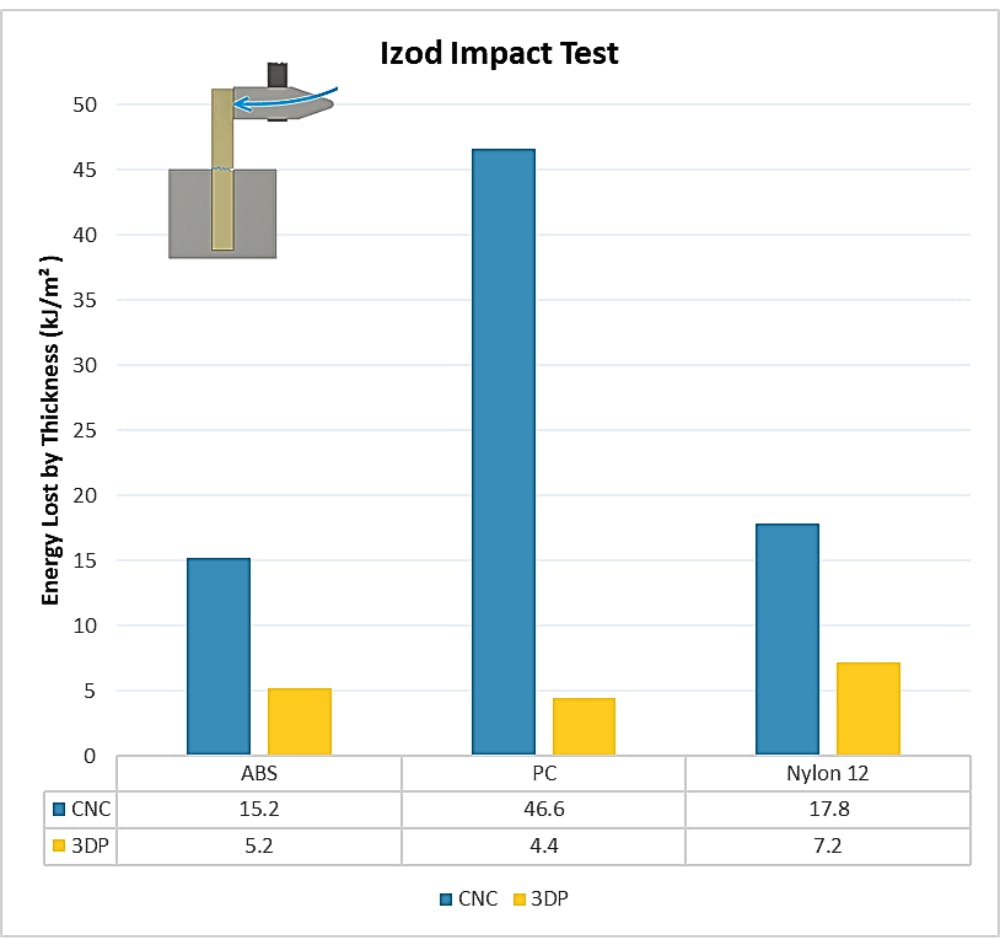
Uniformity of properties
CNC machining is generally more reliable for consistency in mechanical properties and durability. It produces parts with isotropic properties (strength in all directions), making it ideal for applications that require structural integrity under varying stress directions. This uniformity is because CNC machining starts with a solid block of material with established, consistent grain structures and properties. 3D printed parts, on the other hand, are weaker along the Z axis, as this is usually the layer consolidation axis.
Surface roughness
The standard CNC machining surface roughness ranges from 3.2 to 0.4 micrometres. 3.2 µm Ra features visible machining marks, while 0.4 µm Ra is a shiny, smooth, reflective surface. Surface roughness varies by 3D printing technology. The layer consolidation technique and layer thickness of the 3D printing technology determine this feature. The image below compares the surface roughnesses of CNC vs 3D printed parts.

CNC Machining vs 3D Printing surface finish
CNC vs 3D Printing Build Size
The maximum product volume a manufacturing process can produce depends on the build volume of their respective machines. CNC machines and 3D printers are available in a wide range of sizes, from desktops to large-scale industrial units. However, directly comparing CNC machines vs 3D printers, the former are typically larger with bigger build volumes. The various types of 3D printer technologies have various maximum build sizes. The table below compares CNC machining technologies and 3D printing technologies.
CNC Machining vs 3D Printing build size

CNC vs 3D Printing Dimensional Accuracy
While 3D printing and CNC machining are sufficiently accurate for most applications, CNC machining can produce tighter tolerances. 3D printing processes are more susceptible to slight dimensional instabilities due to temperature variations and postprocessing operations. The table below compares the tolerance and accuracies of CNC machining vs 3D printing technologies.
CNC vs 3D printing dimensional accuracy

Conclusion
CNC machining and 3D printing are advanced manufacturing technologies, each with distinct strengths and limitations. CNC machining excels in precision, material versatility, and producing highly accurate parts with tight tolerances, making it ideal for large-scale production and parts requiring structural integrity. On the other hand, 3D printing offers greater design freedom and material efficiency and is more cost-effective for rapid prototyping and complex geometries. The choice between the two depends on project-specific factors such as geometry complexity, material requirements, production volume, and cost considerations.
Why Choose Geomiq
Need Plastic Manufacturing services? Geomiq is your ultimate custom manufacturer for all your CNC machining and 3D printing needs. We offer over 100 industrial-grade plastics and metals for CNC machining and 3D printing projects. You can also request custom materials. Whether for one-off parts or bulk production, we combine state-of-the-art equipment, advanced machining techniques, and stringent quality assurance to ensure you receive accurate, high-quality, error-free parts in as little as three days - the first time, every time.
Simply Upload your design to our instant quoting platform and select your desired specifications to get started. You’ll receive a tailored instant quote, complete with pricing and lead times. You can also contact us to discuss your project with our team of manufacturing professionals.
About the author
Sam Al-Mukhtar
Mechanical Engineer, Founder and CEO of Geomiq
Mechanical Engineer, Founder and CEO of Geomiq, an online manufacturing platform for CNC Machining, 3D Printing, Injection Moulding and Sheet Metal fabrication. Our mission is to automate custom manufacturing, to deliver industry-leading service levels that enable engineers to innovate faster.